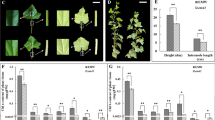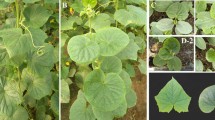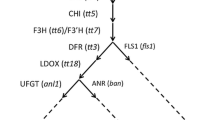Abstract
Key message
The seedless mutant tn-1 in chili pepper is caused by a mutation in CaCKI1 (CA12g21620), which encodes histidine kinase involving female gametophyte development. An amino acid insertion in the receiver domain of CaCKI1 may be the mutation responsible for tn-1 .
Abstract
Seedlessness is a desirable trait in fruit crops because the removal of seeds is a troublesome step for consumers and processing industries. However, little knowledge is available to develop seedless chili peppers. In a previous study, a chili pepper mutant tn-1, which stably produces seedless fruits, was isolated. In this study, we report characterization of tn-1 and identification of the causative gene. Although pollen germination was normal, confocal laser microscopy observations revealed deficiency in embryo sac development in tn-1. By marker analysis, the tn-1 locus was narrowed down to a 313 kb region on chromosome 12. Further analysis combined with mapping-by-sequencing identified CA12g21620, which encodes histidine kinase as a candidate gene. Phylogenetic analysis revealed CA12g21620 was the homolog of Arabidopsis CKI1 (Cytokinin Independent 1), which plays an important role in female gametophyte development, and CA12g21620 was designated as CaCKI1. Sequence analysis revealed that tn-1 has a 3-bp insertion in the 6th exon resulting in one lysine (K) residue insertion in receiver domain of CaCKI1, and the sequence nearby the insertion is widely conserved among CKI1 orthologs in various plants. This suggested that one K residue insertion may reduce the phosphorylation relay downstream of CaCKI1 and impair normal development of female gametophyte, resulting in seedless fruits production in tn-1. Furthermore, we demonstrated that virus-induced gene silencing of CaCKI1 reduced normally developed female gametophyte in chili pepper. This study describes the significant role of CaCKI1 in seed development in chili pepper and the possibility of developing seedless cultivars using its mutation.









Similar content being viewed by others
Availability of data and materials
Relevant data are included in this paper and its associated Supplementary Information.
References
Ampomah-Dwamena C, Morris BA, Sutherland P, Veit B, Yao JL (2002) Down-regulation of TM29, a tomato SEPALLATA homolog, causes parthenocarpic fruit development and floral reversion. Plant Physiol 130:605–617
Bassel GW, Mullen RT, Bewley JD (2008) Procera is a putative DELLA mutant in tomato (Solanum lycopersicum): effects on the seed and vegetative plant. J Exp Bot 59:585–593
Beraldi D, Picarella ME, Soressi GP, Mazzucato A (2004) Fine mapping of the parthenocarpic fruit (pat) mutation in tomato. Theor Appl Genet 108:209–216
Bosland PW, Votava EJ (2000) Peppers:vegetable and spice capsicums. CABI Publishing, New York
Christensen CA, King EJ, Jordan JR, Drews GN (1997) Megagametogenesis in Arabidopsis wild type and the Gf mutant. Sex Plant Reprod 10:49–64
D’Agostino IB, Kieber JJ (1999) Phosphorelay signal transduction: the emerging family of plant response regulators. Trends Biochem Sci 24:452–456
Dalal M, Dani RG, Kumar PA (2006) Current trends in the genetic engineering of vegetable crops. Sci Hortic 107:215–225
Daskalov S, Poulos JM (1994) Updated Capsicum gene list. Capsicum Eggplant Nswl 13:16–26
Deng Y, Dong H, Mu J, Ren B, Zheng B, Ji Z, Yang WC, Liang Y, Zuo J (2010) Arabidopsis histidine kinase CKI1 acts upstream of HISTIDINE PHOSPHOTRANSFER PROTEINS to regulate female gametophyte development and vegetative growth. Plant Cell 22:1232–1248
DePristo MA, Banks E, Poplin R, Garimella KV, Maguire JR, Hartl C, Philippakis AA et al (2011) A framework for variation discovery and genotyping using next-generation DNA sequencing data. Nat Genet 43:491–498
Fos M, Nuez F, Garcia-Martinez JL (2000) The gene pat-2, which induces natural parthenocarpy, alters the gibberellin content in unpollinated tomato ovaries. Plant Physiol 122:471–479
George AP, Mowat AD, Collins RJ, Morley-Bunker M (1997) The pattern and control of reproductive development in non-astringent persimmon (Diospyros kaki L.). Sci Hortic 70:93–122
Gorguet B, Eggink PM, Ocaña J, Tiwari A, Schipper D, Finkers R, Visser RGF, Heusden AW (2008) Mapping and characterization of novel parthenocarpy QTLs in tomato. Theor Appl Genet 116:755–767
Goto S, Yoshioka T, Ohta S, Kita M, Hamada H, Shimizu T (2018) QTL mapping of male sterility and transmission pattern in progeny of Satsuma mandarin. PLoS ONE 13:e0200844
He Y, Liu X, Ye L, Pan C, Chen L, Zou T, Lu G (2016) Genome–wide identification and expression analysis of two–component system genes in tomato. Int J Mol Sci 17:1204
Hejátko J, Pernisová M, Eneva T, Palme K, Brzobohatý B (2003) The putative sensor histidine kinase CKI1 is involved in female gametophyte development in Arabidopsis. Mol Genet Genom 269:443–453
Hejátko J, Ryu H, Kim GT, Dobešova R, Choi S, Choi SM, Souček P, Horak J, Pekarova B, Palme K, Brzobohaty B, Hwang I (2009) The histidine kinases CYTOKININ-INDEPENDENT1 and ARABIDOPSIS HISTIDINE KINASE2 and 3 regulate vascular tissue development in Arabidopsis shoots. Plant Cell 21:2008–2021
Hoang XLT, Prerostova S, Thu NBA, Thao NP, Vankova R, Tran LSP (2021) Histidine kinases: diverse functions in plant development and responses to environmental. Annu Rev Plant Biol 72:297–323
Honda I, Matsunaga H, Kikuchi K, Matsuo S, Fukuda M (2012) Identification of pepper (Capsicum annuum L.) accessions with large or small fruit that have a high degree of parthenocarpy. Sci Hortic 135:68–70
Hwang I, Sheen J (2001) Two-component circuitry in Arabidopsis cytokinin signal transduction. Nature 413:383–389
Hwang I, Chen HC, Sheen J (2002) Two–component signal transduction pathways in Arabidopsis. Plant Physiol 129:500–515
Hwang I, Sheen J, Müller B (2012) Cytokinin Signaling Networks. Annu Rev Plant Biol 63:353–380
Joldersma D, Liu Z (2018) The making of virgin fruit: the molecular and genetic basis of parthenocarpy. J Ex Bot 69:955–962
Kakimoto T (1996) CKI1, a histidine kinase homolog implicated in cytokinin signal transduction. Science 274:982–985
Kaur M, Sharma P (2021) Recent advances in cucumber (Cucumis sativus L.). J Hortic Sci Biotechnol 97:3–23
Kihara H (1951) Triploid watermelons. Proc Am Soc Hort Sci 58:217–230
Kim S, Park M, Yeom SI, Kim YM, Lee JM, Lee HA, Seo E et al (2014) Genome sequence of the hot pepper provides insights into the evolution of pungency in Capsicum species. Nat Genet 46:270–278
Kim J, Park M, Jeong ES, Lee JM, Choi D (2017) Harnessing anthocyanin-rich fruit: a visible reporter for tracing virus-induced gene silencing in pepper fruit. Plant Methods 13:3
Klap C, Yeshayahou E, Bolger AM, Arazi T, Gupta SK, Shabtai S, Usadel B, Salts Y, Barg R (2017) Tomato facultative parthenocarpy results from SlAGAMOUS-LIKE 6 loss of function. Plant Biotechnol J 15:634–647
Li H, Durbin R (2010) Fast and accurate long-read alignment with Burrows-Wheeler transform. Bioinformatics 26:589–595
Liu Y, Schiff M, Marathe R, Dinesh-Kumar SP (2002) Tobacco Rar1, EDS1 and NPR1/NIM1 like genes are required for N-mediated resistance to tobacco mosaic virus. Plant J 30:415–429
Matsuo S, Miyatake K, Endo M, Urashimo S, Kawanishi T, Negoro S, Shimakoshi S, Fukuoka H (2020) Loss of function of the Pad-1aminotransferase gene, which is involved in auxin homeostasis, induces parthenocarpy in Solanaceae plants. Proc Natl Acad Sci USA 117:12784–12790
Mazzucato A, Taddei AR, Soressi GP (1998) The parthenocarpic fruit (pat) mutant of tomato (Lycopersicon esculentum Mill.) sets seedless fruits and has aberrant anther and ovule development. Development 125:107–114
Miyatake K, Takeo Saito T, Negoro S, Yamaguchi H, Nunome T, Ohyama A, Fukuoka H (2012) Development of selective markers linked to a major QTL for parthenocarpy in eggplant (Solanum melongena L.). Theor Appl Genet 124:1403–1413
Pekárová B, Klumpler T, Třísková O, Horák J, Jansen S, Dopitová R, Borkovcová P, Papoušková V, Nejedlá E, Sklenář V, Marek J, Žídek L, Hejátko J (2011) Structure and binding specificity of the receiver domain of sensor histidine kinase CKI1 from Arabidopsis thaliana. Plant J 67:827–839
Pike LM, Peterson CE (1969) Inheritance of parthenocarpy in the cucumber (Cucumis sativus L.). Euphytica 18:101–105
Pischke MS, Jones LG, Otsuga D, Fernandez DE, Drews GN, Sussman MR (2002) An Arabidopsis histidine kinase is essential for megagametogenesis. Proc Natl Acad Sci 99:15800–15805
Prolaram B, Christopher T, Subhash K (1990) Seedless fruit mutant in Capsicum. Capsicum Nswl 89:45–46
Quinet M, Bataille G, Dobrev PI, Capel C, Gómez P, Capel J, Lutts S, Motyka V, Angosto T, Lozano R (2014) Transcriptional and hormonal regulation of petal and stamen development by STAMENLESS, the tomato (Solanum lycopersicum L.) orthologue to the B-class APETALA3 gene. J Exp Bot 65:2243–2256
Rao PG, Prasad BVG, Kumar TK, Tirupathamma TL, Roshni P, Tejaswini T (2018) Breeding for climate resilient parthenocarpic vegetables. Int J Curr Microbiol App Sci 7:2473–2492
Reig C, Martínez-Fuentes A, Mesejo C, Agustí M (2018) Hormonal control of parthenocarpic fruit set in ‘Rojo Brillante’ persimmon (Diospyros kaki Thunb.). J Plant Physiol 231:96–104
Shinozaki Y, Hao S, Kojima M, Sakakibara H, Ozeki-Iida Y, Zheng Y, Fei Z, Zhong S, Giovannoni JJ, Rose JKC, Okabe Y, HetaY EH, Ariizumi T (2015) Ethylene suppresses tomato (Solanum lycopersicum) fruit set through modification of gibberellin metabolism. Plant J 83:237–251
Sogi DS, Bhatia R, Garg SK, Bawa AS (2005) Biological evaluation of tomato waste seed meals and protein concentrate. Food Chem 89:53–56
Subbaraya U, Rajendran S, Simeon S, Suthanthiram B, Saraswathi MS (2020) Unravelling the regulatory network of transcription factors in parthenocarpy. Sci Hortic 261:108920
Takagi H, Abe A, Yoshida K, Kosugi S, Natsume S, Mitsuoka C et al (2013) QTL-seq: rapid mapping of quantitative trait loci in rice by whole genome resequencing of DNA from two bulked populations. Plant J 74:174–183
Takisawa R, Takayuki Maruyama T, Nakazaki T, Kataoka K, Saito H, Koeda S, Nunome T, Fukuoka H, Kitajima A (2017) Parthenocarpy in the tomato (Solanum lycopersicum L.) cultivar ‘MPK-1’ is controlled by a novel parthenocarpic gene. Hort J 86:487–492
Takisawa R, Nakazaki T, Nunome T, Fukuoka H, Kataoka K, Saito H, Habu T, Kitajima A (2018) The parthenocarpic gene Pat-k is generated by a natural mutation of SlAGL6 affecting fruit development in tomato (Solanum lycopersicum L.). BMC Plant Biol 18:72
Tanaka Y, Mitani A, Shimizu N, Goto T, Yoshida Y, Yasuba K (2021) Characterization and bulk segregant analysis of a novel seedless mutant tn-1 of chili pepper (Capsicum annuum). Sci Hortic 276:109729
Tanaka Y, Yokota M, Goto N, Goto T, Yoshida Y, Yasuba K, Ohno S, Doi M (2022) Morphological and gene expression characterization of maf-1, a floral chili pepper mutant caused by a nonsense mutation in CaLFY. Mol Breed 42:32
Tiwari A, Dassen H, Heuvelink E (2007) Selection of sweet pepper (Capsicum annuum) genotypes for parthenocarpic fruit growth. Acta Hortic 761:135–140
Tiwari A, Vivian-Smith A, Voorrips RE, Habets ME, Xue LB, Offringa R, Heuvelink E (2011) Parthenocarpic potential in Capsicum annuum L. is enhanced by carpelloid structures and controlled by a single recessive gene. BMC Plant Biol 11:143
Ueguchi C, Koizumi H, Suzuki T, Mizuno T (2001) Novel family of sensor histidine kinase genes in Arabidopsis thaliana. Plant Cell Physiol 42:231–235
Vardi A, Levin I, Carmi N (2008) Induction of seedlessness in Citrus: from classical techniques to emerging biotechnological approaches. J Am Soc Hort Sci 133:117–126
Varoquaux F, Blanvillain R, Delseny M, Gallois P (2000) Less is better: new approaches for seedless fruit production. Trends Biotechnol 18:233–242
Wang D, Bosland PW (2006) The Genes of Capsicum Hort Sci 41:1169–1187
Yamada H, Suzuki T, Terada K, Takei K, Ishikawa K, Miwa K, Yamashino T, Mizuno T (2001) The Arabidopsis AHK4 histidine kinase is a cytokinin-binding receptor that transduces cytokinin signals across the membrane. Plant Cell Physiol 42:1017–1023
Yamazaki A, Hosokawa M (2019) Increased percentage of fruit set of F1 hybrid of Capsicum chinense during high–temperature period. Sci Hortic 243:421–427
Yuan L, Liu Z, Song X, Johnson C, Yu X, Sundaresan V (2016) The CKI1 histidine kinase specifies the female gametic precursor of the endosperm. Dev Cell 37:34–46
Zhoua X, Wakana A, Kim JH, Sakai K, Kajiwara K, Mizunoe Y (2018) Parthenocarpy in Citrus accessions with special focus on relatives of Kunenbo (C. nobilis Lour. var. kunep Tanaka). Sci Hortic 232:29–39
Acknowledgements
Computations were partially performed on the NIG supercomputer at ROIS National Institute of Genetics. We would like to express our gratitude to Dr. Yukiko Yasui for providing a valuable opportunity to initiate the CLSM observations. TRV1 (Addgene plasmid # 148968) and TRV2(Addgene plasmid # 148969) vectors were gifts from Savithramma Dinesh-Kumar. The NMH seeds were kindly provided by Dr. Sota Koeda (Kindai University).
Funding
This study was supported in part by a Grant-in-Aid for Scientific Research (B) (21H02187).
Author information
Authors and Affiliations
Contributions
YT designed the research and performed mapping-by-sequencing analysis. TM conducted identification of the tn-1 gene, sequence analysis of CaCKI1, gene expression analysis, and microscopy analysis of ovule structures. YM participated in genetic analysis. HK and AY conducted the pollen germination tests. SY participated in CLSM observations on ovule structures. SO assisted with the development of DNA markers using genome resequencing data. MD assisted with the cultivation of plant materials and contributed in the interpretation of CaCKI1 function. TM wrote the draft of the manuscript, and YT edited it. All authors read and approved the final manuscript.
Corresponding author
Ethics declarations
Conflict of interest
The authors declare that they have no conflict of interest.
Ethics approval and consent to participate
Not applicable.
Consent for publication
Not applicable.
Additional information
Communicated by Esther van der Knaap.
Publisher's Note
Springer Nature remains neutral with regard to jurisdictional claims in published maps and institutional affiliations.
Supplementary Information
Below is the link to the electronic supplementary material.
122_2023_4342_MOESM2_ESM.jpeg
Figure S2 Flow of the mapping-by-sequencing approach for identification of the causative mutation in the tn-1 mutant (JPEG 579 KB)
122_2023_4342_MOESM3_ESM.jpeg
Figure S3 ΔSNP-index plots across the whole genome to identify candidate a mutation of tn-1. ΔSNP-index was calculated as: ΔSNP-index = tn-1-bulk SNP-index – WT-bulk SNP index (SNP-index indicates the ratio of tn-1 type reads per total reads). Red plots show 7 SNPs with high ΔSNP-index (>0.7) (JPEG 548 KB)
122_2023_4342_MOESM4_ESM.jpg
Figure S4 Comparison of CaCKI1 gene structures. YM, tn-1, CM334 (annotated in CM334 v.1.55) and Zunla (annotated in Zunla v.2.0) from top (JPG 58 KB)
122_2023_4342_MOESM6_ESM.jpg
Figure S6 Predicted 3D structure of the receiver domain of CaCKI1. A green arrow indicates the 1 amino acid (K) insertion in tn-1. Yellow arrows indicate different structures between WT and tn-1 (JPG 98 KB)
Rights and permissions
Springer Nature or its licensor (e.g. a society or other partner) holds exclusive rights to this article under a publishing agreement with the author(s) or other rightsholder(s); author self-archiving of the accepted manuscript version of this article is solely governed by the terms of such publishing agreement and applicable law.
About this article
Cite this article
Maki, T., Kusaka, H., Matsumoto, Y. et al. The mutation of CaCKI1 causes seedless fruits in chili pepper (Capsicum annuum). Theor Appl Genet 136, 85 (2023). https://doi.org/10.1007/s00122-023-04342-w
Received:
Accepted:
Published:
DOI: https://doi.org/10.1007/s00122-023-04342-w




